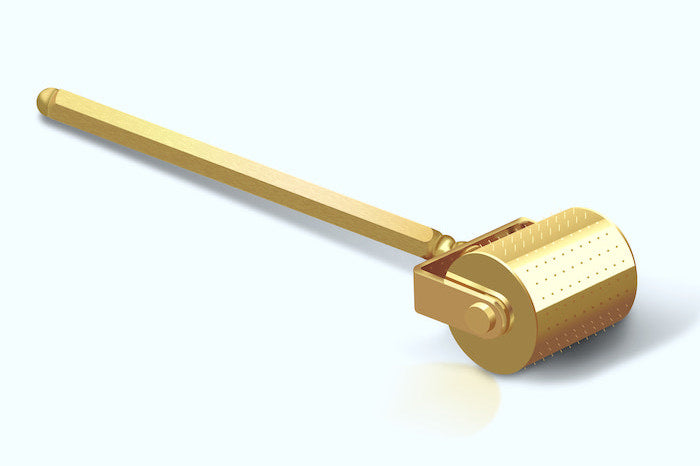
Derma Roller For Face, Scars & Wrinkles: Benefits, Uses and More
A derma roller, also known as a microneedle roller or a skin roller, is a handheld device equipped with a wheel of micro-needles.
It is specifically designed to create minor skin pricks that stimulate the body's natural healing response, leading to increased collagen and elastin production.
The derma roller's primary purpose when used on the face is to improve skin texture, reduce signs of aging, enhance the effectiveness of skincare products.
In this comprehensive guide, we'll take a deep dive into the remarkable world of derma rollers for face.
How a Face Needle Roller Works:
The derma roller works by creating minute, controlled skin injuries.
These tiny punctures, invisible to the naked eye, trigger the body's wound healing response, resulting in the production of collagen and elastin, two proteins responsible for skin elasticity and firmness.
Besides, the punctures also create channels that allow for better absorption of skincare products, making them more effective.
Derma Roller for Face: Benefits
Collagen Production and Skin Rejuvenation:
The face needle roller plays a vital role in stimulating collagen production in the skin.
When the needles penetrate the skin, they cause a slight trauma, which, in turn, activates the body's healing response.
This response involves an increase in collagen and elastin production, rejuvenating the skin and restoring its youthful appearance (1).
Effects on Acne Scars and Wrinkles:
One of the most celebrated benefits of the derma roller for the face is its ability to reduce the appearance of acne scars and wrinkles.
As the skin produces more collagen in response to micro-needling, it can plump up and smooth out the skin, reducing the visibility of acne scars and wrinkles (2).
Enhancing Absorption of Skincare Products:
Derma rollers also play a crucial role in making skincare products more effective.
The tiny holes created by the derma roller make it easier for skincare products to penetrate the skin's surface, thereby maximizing their benefits (3).
Derma Roller for Face: Scars
Whether you're dealing with acne scars or surgery marks, a derma roller can help reduce their appearance. By promoting skin cell turnover and collagen production, the derma roller can gradually smooth out the scar tissue, improving the skin's overall texture and appearance (4).
Derma Roller for Face: Wrinkles
Wrinkles are a natural part of the aging process, but they can also be effectively managed with the right tools. Regular use of a derma roller can help to fill in fine lines and wrinkles, making them less noticeable and giving the skin a more youthful appearance (5).
Derma Roller for Face: Beard
While this might be a less common application, derma rollers can also promote beard growth. The needles stimulate blood circulation in the facial area, which can help stimulate the growth and thickness of the facial hair (6).
How to Use a Derma Roller on Your Face
Step-by-step guide to using a derma roller for face:
Using a face needle roller may seem intimidating at first, but once you understand the process, it becomes a simple addition to your skincare routine.
Here are the steps:
1. Start by cleansing your face with a gentle cleanser to remove any dirt or makeup.
2. Apply a numbing cream if needed.
3. Disinfect the derma roller by submerging it in alcohol for about 10 minutes, then let it air dry.
4. Apply your serum or skincare product to your face.
5. Gently roll the derma roller across your skin, moving it horizontally, vertically, and diagonally, lifting the roller after each pass. Roll it 6-10 times in each direction.
6. After rolling, apply another layer of your skincare product.
7. Rinse the roller under warm water, then disinfect it again before storing it safely.
Recommendations on frequency:
The frequency of using a derma roller depends on the needle size.
For 0.25mm needles, you can use it every other day.
For 0.5mm needles, once a week is recommended, and for needles 1mm or longer, it should be every 3 to 4 weeks.
Always follow the manufacturer's instructions and consult with a skincare professional if you're unsure.
Importance of cleaning and hygiene:
Keeping your derma roller clean is crucial to prevent infections.
Always disinfect your roller before and after each use.
Never share your derma roller with anyone else, and replace it after 10-15 uses, or as suggested by the manufacturer.
Choosing the Right Derma Roller for Your Face
What needle size is best for face?
Needle size depends on your skin's condition and your specific goals.
For general facial rejuvenation, 0.5mm to 1mm is a good starting point.
For deeper scars or wrinkles, a size up to 1.5mm can be used.
But remember, larger needles increase the risk of side effects and require more downtime.
Factors to consider when choosing a face needle roller:
Consider the needle material (titanium is durable but stainless steel is sharper), the needle count (more needles isn't necessarily better), and the handle design (comfortable grip is important).
Reading product reviews and consulting with skincare professionals can be helpful.
Potential Side Effects and Considerations
Discuss potential risks associated with face needle roller use:
Side effects of derma rolling can include redness, irritation, and swelling, which typically subside within a few days.
There's also a risk of infection if the roller isn't properly cleaned, or if it's used on open wounds or active acne.
Safety tips and precautions for users:
Always start with a patch test to see how your skin responds.
Avoid using a derma roller if you have active acne, open wounds, or any skin condition like psoriasis or eczema. Also, don't use it on your eyelids as the skin there is too thin.
Conclusion
From boosting collagen production to reducing the appearance of scars and wrinkles, a derma roller is a powerful tool in your skincare arsenal.
Not only can it rejuvenate your skin, but it can also enhance the effectiveness of your skincare products.
While it may be a new concept for many, using a face needle roller has the potential to dramatically improve the health and appearance of your skin.
We encourage you to explore the possibilities this tool offers and consider adding it to your skincare regimen.
We recommend you get the FullyVital derma roller for face and hair.
Frequently Asked Questions On Dermaroller For Face (FAQ)
What are the disadvantages of derma roller on face?
Despite the numerous benefits, derma rolling also has potential disadvantages. If improperly used, it can lead to skin irritation, inflammation, redness, or even minor bleeding.
The risk of infection increases if the face needle roller isn't appropriately sterilized. Overuse can lead to skin sensitivity and may disrupt the skin's barrier function.
It's also not suitable for everyone; those with active acne, skin infections, or certain skin conditions like rosacea should avoid it.
It's best to consult a skincare professional before starting derma rolling.
Can I use 0.5 derma roller everyday for face?
Typically, it's not advisable to use a 0.5 mm derma roller on your face daily. The 0.5mm size creates microchannels in your skin, which requires a recovery period.
Experts often suggest using a 0.5mm face needle roller once a week to allow the skin ample time to heal and regenerate.
Overuse can lead to skin irritation and compromise the skin's natural barrier.
Can you put serum on before or after dermarolling?
Using a serum in conjunction with a derma roller can be highly beneficial.
The most effective method is to apply the serum after derma rolling.
The process of derma rolling creates small microchannels in your skin, which enhances the absorption of skincare products.
So, applying your serum after using the face roller allows it to penetrate deeper into your skin, increasing its effectiveness.
It's important, however, to ensure that the serum is non-irritating and suited for use with a derma roller, as some ingredients may cause irritation when they penetrate beyond the skin's surface.
Are derma rollers good for your face?
Yes, derma rollers can be excellent for your face, given their potential to stimulate collagen production, reduce the appearance of acne scars and wrinkles, and enhance the absorption of skincare products.
The process, known as micro-needling, works by creating micro-injuries on the skin's surface, triggering a wound healing response that leads to cell turnover and increased collagen and elastin production.
This can result in a more youthful and radiant complexion.
Are face needle rollers and derma rollers the same?
Yes, face needle rollers and derma rollers refer to the same device. Another term used to describe these devices is microneedle.
Can I use derma roller for eyes?
Yes, you can use a derma roller for the eye area, but extreme caution is needed due to the sensitivity of the skin around the eyes.
It's recommended to use a face needle roller with very short needles (0.25mm to 0.5mm) for this area.
The procedure can help stimulate collagen production, reducing the appearance of fine lines and wrinkles around the eyes.
However, never use the roller directly on your eyelids or too close to the eyes to avoid injury.
Can I user derma roller for skin?
Absolutely, derma rollers were specifically designed for skin use.
They work by creating tiny punctures on the skin's surface, which triggers the body's healing response, stimulating collagen and elastin production.
This can result in improved skin texture, reduced appearance of scars and wrinkles, and overall skin rejuvenation.
However, it's important to use the correct needle size for your skin concerns and follow a proper aftercare routine to avoid potential side effects.
References:
- Aust, M. C., Fernandes, D., Kolokythas, P., Kaplan, H. M., & Vogt, P. M. (2008). Percutaneous collagen induction therapy: An alternative treatment for scars, wrinkles, and skin laxity. Plastic and Reconstructive Surgery, 121(4), 1421–1429.
- El-Domyati, M., Barakat, M., Awad, S., Medhat, W., El-Fakahany, H., & Farag, H. (2015). Microneedling Therapy for Atrophic Acne Scars: An Objective Evaluation. Journal of Clinical and Aesthetic Dermatology, 8(7), 36–42.
- Majid, I. (2009). Microneedling therapy in atrophic facial scars: an objective assessment. Journal of cutaneous and aesthetic surgery, 2(1), 26–30.
- Schwartz, T., Krueger, N., & Korber, A. (2018). A Randomized, Split-Face, Histomorphologic Study Comparing a Microneedle Roller with a Fractional Laser. Dermatology (Basel, Switzerland), 234(4–6), 130–140.
- Karimipour, D. J., Karimipour, G., & Orringer, J. S. (2010). Microdermabrasion: an evidence-based review. Plastic and reconstructive surgery, 125(1), 372–377.
- Dhurat, R., & Sukesh, M. S. (2016). Principles and Methods of Preparation of Platelet-Rich Plasma: A Review and Author's Perspective. Journal of cutaneous and aesthetic surgery, 9(4), 227–230.
-
Lima, E. V. A., Lima, M. A. L. M., Frade, M. A. C., & Munin, E. (2012). Comparative study of topical green and red propolis in the repair of wounds induced in rats. Revista do Colégio Brasileiro de Cirurgiões, 39(4), 515–520.
-
Doddaballapur, S. (2009). Microneedling with dermaroller. Journal of cutaneous and aesthetic surgery, 2(2), 110–111.
-
Farhi, M. (2018). MicroNeedling Facial Treatment. The Aesthetic Guide.
-
Alam, M., & Dover, J. S. (2014). A systematic review of microneedling. Facial plastic surgery clinics of North America, 22(4), 419–430.





